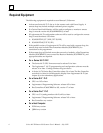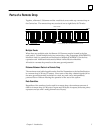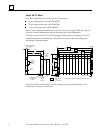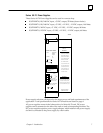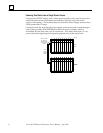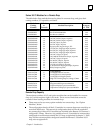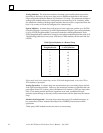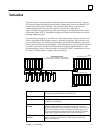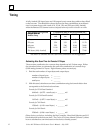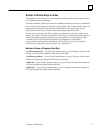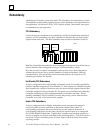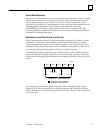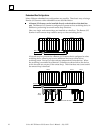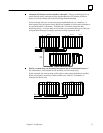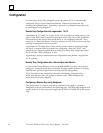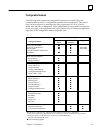
1
Series 90–70 Remote I/O Scanner User’s Manual – July 199212
Timing
A fully–loaded (128 input bytes and 128 output bytes) remote drop adds at least 20mS
to the bus scan. The table below shows the bus scan time contribution, at each baud
rate, for remote drops with a total of 16, 32, 64, 128, and 256 bytes (fully–loaded),
when the Remote I/O Scanner receives outputs from only one bus controller at a time.
Total Amount of Input and
Output Data for
Contribution time in mS at each baud rate *
Total Amount of Input and
Output Data for
Remote Drop
153.6 Kb
std
153.6 Kb
ext
76.8 Kb 38.4 Kb
16 bytes 2.09 2.16 3.83 7.16
32 bytes 3.24 3.31 6.12 11.74
64 bytes 5.52 5.60 10.69 20.89
128 bytes 10.10 10.17 19.85 39.20
256 bytes (fully–loaded) 19.25 19.32 38.15 75.80
* See below to calculate the exact scan time contribution for the application.
Estimating Bus Scan Time for Remote I/O Drops
The scan time contribution for a remote drop depends on its I/O data usage. Follow
the procedure below to estimate the the scan time contribution of a remote drop.
(Each analog channels is 2 bytes. Eight discrete points are one byte).
1. Find the total number of input bytes and output bytes.
number of input bytes = ________
number of output bytes = ________
total bytes = ________
2. With this total, calculate a scan time contribution using the formula below that
corresponds to the Genius bus baud rate.
Formula for 153.6 Kbaud Standard:
0.943mS + (0.0715 x total bytes) = ________ mS
Formula for 153.6 Kbaud Extended:
1.015mS + (0.0715 x total bytes) = ________ mS
Formula for 76.8 Kbaud:
1.538mS + (0.143 x total bytes) = ________ mS
Formula for 38.4 Kbaud:
2.583mS + (0.286 x total bytes) = ________ mS
Other devices on the bus, including the Bus Controller, Hand–held Monitor, and I/O
blocks also add to the bus scan time. The Genius I/O System Manual (Volume 1) shows
how to calculate bus scan time based on the devices actually present.



